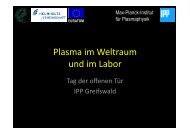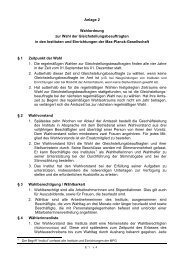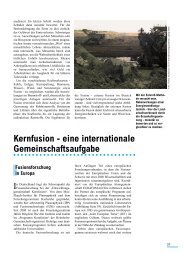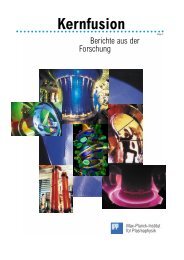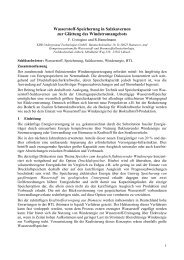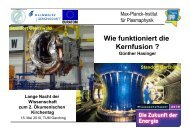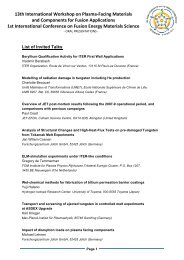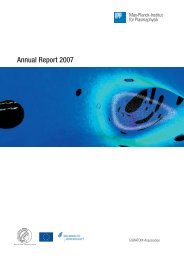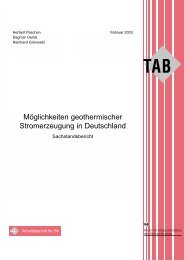Wendelstein 7-X and fusion - Max-Planck-Institut für Plasmaphysik
Wendelstein 7-X and fusion - Max-Planck-Institut für Plasmaphysik
Wendelstein 7-X and fusion - Max-Planck-Institut für Plasmaphysik
You also want an ePaper? Increase the reach of your titles
YUMPU automatically turns print PDFs into web optimized ePapers that Google loves.
12<br />
Large corporations<br />
Target elements during thermographic testing<br />
Facts:<br />
Research institutes:<br />
<strong>Max</strong> <strong>Planck</strong> <strong>Institut</strong>e for Plasma Physics<br />
Industrial partner:<br />
Plansee SE (Reutte, Austria)<br />
Contracts:<br />
Development <strong>and</strong> production of elements<br />
for the first wall, particularly within the field<br />
of divertors<br />
Thus, the development of high-performance divertors has become necessary. Plansee<br />
SE has designed so called “target elements” for the divertors, which must be continuously<br />
capable of withst<strong>and</strong>ing 10 megawatts per square metre. A sophisticated combination<br />
of carbon-fibre-reinforced carbon <strong>and</strong> water-cooled metal blocks, also known as<br />
heat sinks, had to be been developed. Significant steps in this development were made<br />
in close collaboration with the <strong>Max</strong> <strong>Planck</strong> <strong>Institut</strong>e for Plasma Physics.<br />
• Joining the carbon-fibre-reinforced carbon to the water-cooled heat sink made of a<br />
metal alloy has turned out to be extraordinarily dem<strong>and</strong>ing. The carbon is in contact<br />
with the plasma <strong>and</strong> exposed to an extremely high heat load; pressurized cooling water<br />
circulates through the heat sink. For joining the two elements, the carbon had to<br />
be coated with a structured copper layer <strong>and</strong> then welded onto the heat sink to ensure<br />
good thermal conductivity from the surface of the carbon layer to the heat sink.<br />
At the same time, it was necessary to compensate for the different thermal expansion<br />
coefficients of the two materials. Plansee has patented the procedure.<br />
• The water-cooled heat sinks must dissipate tremendous quantities of heat under<br />
conditions of continuous operation. The pressurized cooling water must be circulated<br />
through the body of the metal heat sink. For this purpose, the cooling channel had to<br />
be designed such that turbulent flow occurs <strong>and</strong> more heat is dissipated.<br />
• Quality assurance for this complex structural element composed of several materials<br />
presented a huge challenge for the production of altogether 890 elements,<br />
representing 18,000 tiles. The <strong>Max</strong> <strong>Planck</strong> <strong>Institut</strong>e for Plasma Physics, together with<br />
its contractor Plansee, developed a quality assurance plan based on both systematic<br />
<strong>and</strong> r<strong>and</strong>omized high-performance tests. Because st<strong>and</strong>ard procedures were not<br />
available for non-destructive checking of joints, the company developed special test<br />
methods on the basis of ultrasonic, X-ray <strong>and</strong> thermographic testing.<br />
The heat load of 10 million Watt per square metre mentioned above are higher than that<br />
placed on the edges of the wing of the space shuttle when it re-enters the atmosphere<br />
(6 million watts per square metre), which, however, “only” occurs for several hundred<br />
seconds in that case. Carbon-fibre-reinforced carbon tiles are also used in that application.<br />
Space technology <strong>and</strong> <strong>fusion</strong> technology have been combined for the development<br />
of materials exposed to high temperatures. Under the management of the IPP, an important<br />
joint European project promoted by the EU under the name EXTREMAT (http://<br />
www. Extremat org.) has been carried out. Plansee played a leading role among the 30<br />
project partners, which are predominantly from the industrial sector.<br />
Using a technology that was introduced for the French <strong>fusion</strong> experiment, Tore Supra,<br />
Plansee <strong>and</strong> the <strong>Max</strong> <strong>Planck</strong> <strong>Institut</strong>e for Plasma Physics have refined it for <strong>Wendelstein</strong><br />
7-X <strong>and</strong> improved its quality <strong>and</strong> reliability. These heat-conducting carbon-fibrereinforced<br />
carbon-metal composites are certain to find a wide range of applications.




